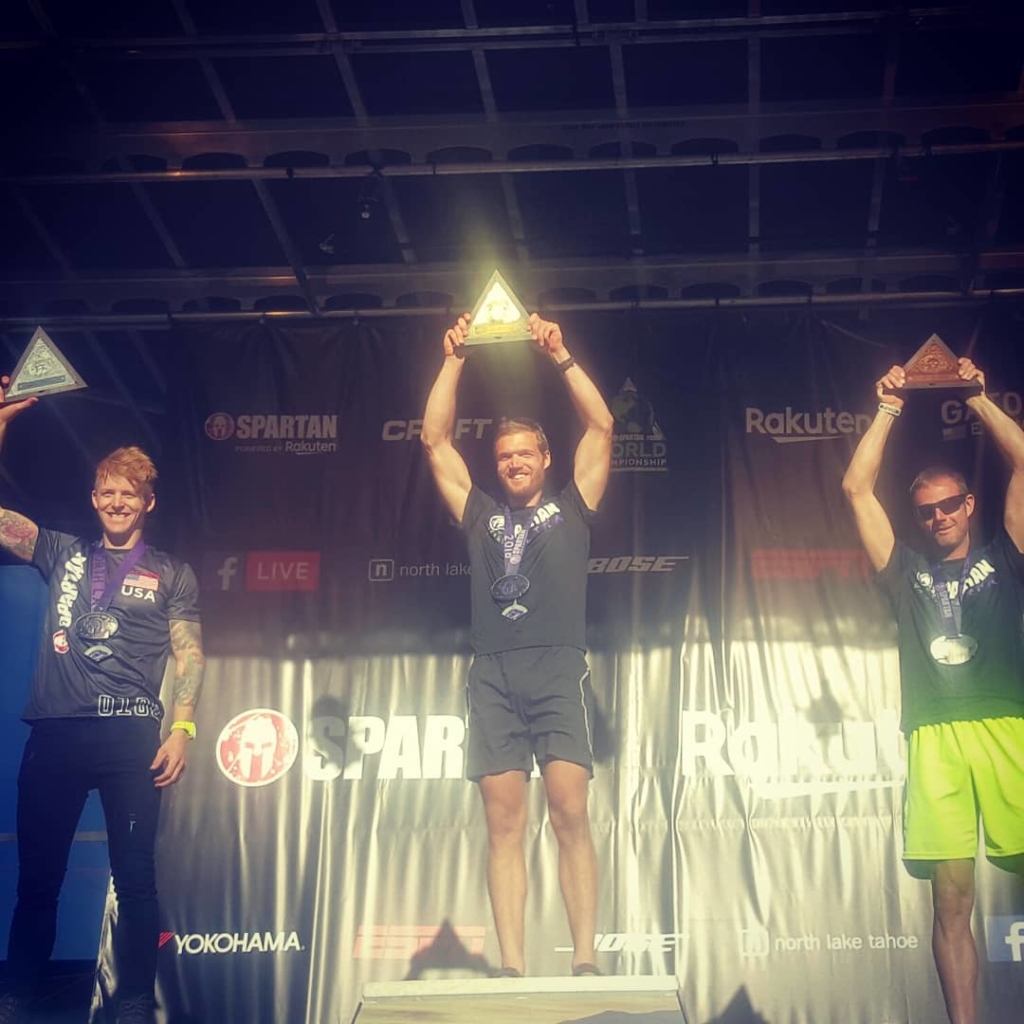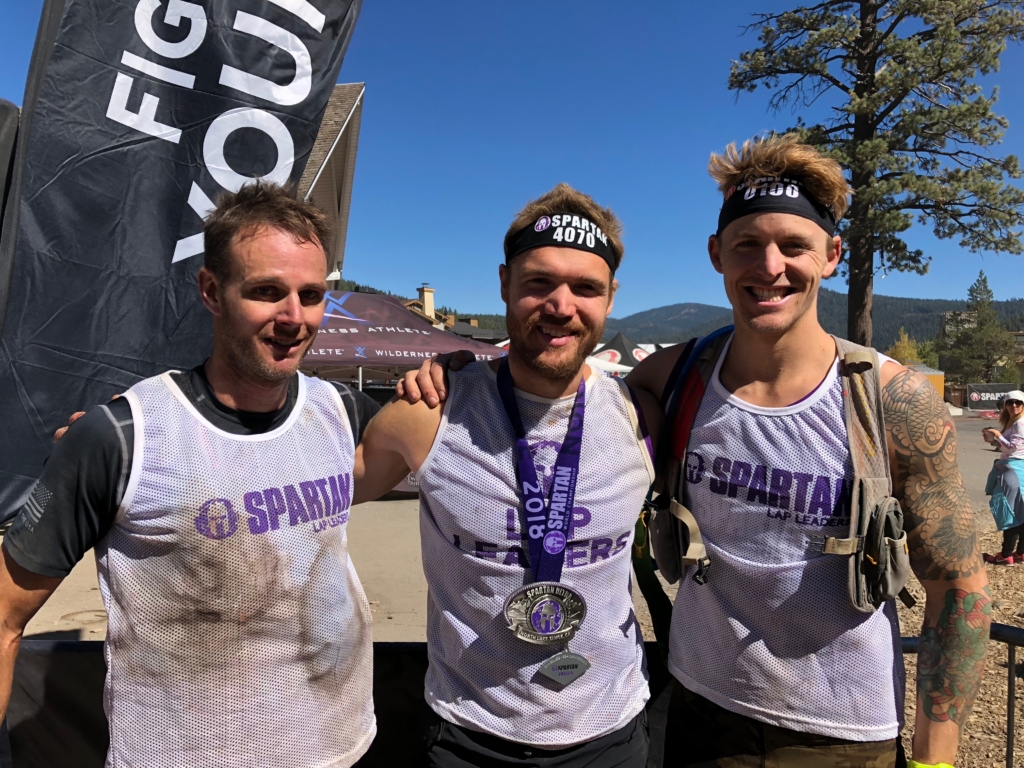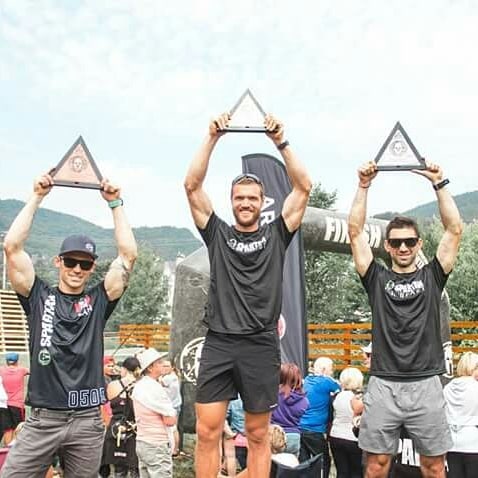
I woke around 3:30 am to eat a healthy size breakfast, big bowl of raisin bran, milk, toast, almond butter, and a banana to make sure my glycogen stores were topped off allowing a few hours for my gut to settle. The race was to start around 6:15 am in the dark with a steady mountain breeze, temperatures around 6 degrees Celsius. I felt quite comfortable in a tight-fitting tank top, shorts and long compression socks. I planned to travel light without a camelback and briefly stop at water stations consuming roughly 2 gels per hour with 1-2 granola bars sometimes on the route.
My only race plan was to go out there and pretend it was a Sunday long run, going by feel and focus on completing every obstacle efficiently without failure. I had no idea how my body would react as my only run at altitude 4 days prior had left me gasping for air with a full-on bloody nose. I chose to arrive a full 7 days prior to adjust and acclimatize to the altitude. I hiked 20-25km nearly every day making sure to get up around 8 to 9 thousand feet in hopes to speed the acclimatization. Any sort of running jacked the heart rate up so I hoped to maintain fitness while tapering by going for these long hikes with short bursts of jogging. Race morning my pulse had skyrocketed, a sign in the past which meant my body was pumped and ready for exertion.
People tore off the start line and I sat back in about 20th; after about 2 miles of climbing half of which were over wood chips on deceivingly steep terrain, I found myself in the top 3. The Hercules Hoist felt a bit heavier than the ones in races back in Canada but I had routinely practiced with 140IBS so it felt relatively light, perhaps around 110IBS. My breathing felt okay, not too labored compared to days prior but certainly not like back home at sea level. I settled into a comfortable pace and felt like I was back home trail running as the route became more technical. Moments before entering the swim area I guess the decision was made to cancel it due to high winds. Somewhat relieved yet a hint of disappointment I was prepared to zip through that water like a fish; the last two months of swimming 3-4hours per week wasn’t going to help me now but perhaps my strengthened diaphragm muscles would.
Grady Jackson, a top OCR ultra racer from the US and I quickly distanced ourselves from the field after a series of carries and a particularly long bucket carry. Just over halfway through the bucket carry Grady lifted the bucket onto his shoulders; a rule specifically prohibited at Spartan race. My arms getting slightly tired as well I chose to follow the rules, fell back a bit but carried it below shoulder level. The official hadn’t said anything which infuriated me; as I left the station I reminded the official and suddenly she began barking orders at the guy behind me doing the same thing!
As we began our descent the anger didn’t subside; even little things after that seemed to piss me off which I won’t go into, the race was on! We were very clean and efficient on all of the obstacles and stormed through the half-mile sandbag carry near the top of the mountain close to 9000 feet. By the bottom of the hill at the tire flip things began to go my way. I’d been known in races and even training sessions to let out belly like screams to help focus and find deep reserves of strength. Without realizing I found myself yelling at the tire unable to get my hands underneath it; I pinch gripped the treads and flipped it letting it crash up and over again up and over a second time. I tore off in what felt like a sprint hardly looking back the rest of the race; from that moment on every kilometer, I seemed to be gaining time. Coming into the transition area more than halfway through I was surprised at how tired my legs felt. They were starting to pull a bit, something I usually didn’t expect to feel until the later stages of an ultra; perhaps I had tapered too much or was burning more calories than anticipated at altitude. The last 10 miles I chose to back off my pace and stay in the fat burning zone so I could conserve energy and not risk running out of fuel and bonking.
At times it felt like I was crawling, at any moment I didn’t know if my legs would cramp or seize up; why hadn’t I felt like this on my training runs?
Perhaps the adrenaline had got the better of me early on? Going through the transition area I was asked to put on a leaders jersey and one of the directors asked if I was going to beat Ryan Atkins time last year; I laughed knowing the course had been longer last year and felt honored to have even been mentioned in the conversation. I expected to feel nervous and perhaps crack in the lead but I felt better like I belonged there; I didn’t care about the past or future, just the present, and complete focus.
The second half mirrored the first with not a single obstacle failed; I was drained but managed to have just enough strength to complete everything. The temperatures rose and I felt that familiar dryness and sun I had been hiking through all week. Every obstacle I faced seemed more challenging that the last, I couldn’t help but notice how loose the cargo netting was while traversing, how much the rungs sagged as I swung across the ape hanger. Thousands of racers in the last day had been through the course and loosened everything up, even the mountain itself seemed to be shaking as huge clouds of dust could be seen miles away down in the valley. Nearly all of the ropes seemed to be worn down to half its original size and was almost expecting it to snap as I climbed.
Quite a few bars and holds were slippery, likely from the drenched gloves of mud, sweat and water from a pool conveniently situated before the tire flip and series of twists and monkey bars. I kept my hands dry by raising my arms over my head as I plunged into the pool from rings above after ringing the bell. The cold water was a relief to the body as my legs felt refreshed and energy levels momentarily peaked. I barely managed the tire flip the second time around; running on near empty the feelings of lethargy and weakness could very well have overwhelmed my mind.
Perhaps all the times flipping that 400-pound tire in my backyard with one arm made the difference; if I could do it with one arm fresh I could do it with two arms tired. Letting out a shriek I did it again this time inching it off the ground to rest on my toes so I would be able to lift with both hands underneath. From there I started to believe deep down I was going to win; just one more climb and descent with a few walls to traverse and the finishing rig which looked fairly straightforward. Hundreds of hours of training had put me in this position; I embraced the challenge of these last 7 kilometers. Although it wasn’t pretty I found myself in a zombie-like shuffle, something between a jog and power walk; it was encouraging to hear other racers and volunteers cheer me on and experience the true spirit of Spartan Race.
As I crested the top of the climb and traversed over the Stairway to Sparta I began the final quad shattering descent not knowing if at any moment one of my legs would seize and buckle. The wide gravel road turned into a technical single track and opened from under the forest canopy and I could see the finish. Any pain I felt from that moment on suddenly disappeared as adrenaline coursed through my veins. At the rig I paused briefly, wiped my hands clean and took a few deep breaths; like a kid at lunch hour I thoroughly enjoyed swinging from ring to ring. I had done what I set out to do and it all came together. Six months prior I had told my father I was going to win this race to raise awareness for mental illness and inspire those struggling with depression to have hope, keep fighting and believe things will get better.

Training
Back home I’m known as being someone who loves nature and spending time outdoors throughout the year. I have a background as an elite trail runner, ultra cyclist and spent most of the winter cross-country skiing. I was prepared both for the cold and the heat often running for hours in temperatures over 95 degrees and in winter including 5-hour skis at a bone-chilling -35 degrees below 0. Frequent training weeks sometimes exceeding 100 miles was not unusual, most of which included slower running paces on trails and softer dirt roads. Add cross training such as cycling, swimming, hiking uphill and strength training sometimes earlier in the season my training weeks would approach the 30-hour mark.

At least 2 hours per week I would spend time doing specific obstacle related exercises like the rope climb, Hercules hoist, 8’ wall traverse, Olympus, spear throw, barbed wire crawl, tire flip, sandbag, and bucket carry; I built all these stations in my backyard! Once a week I would do these exercises with added weight or while wearing a 55-pound vest to gain strength in these specific movements required during a race. I focused on the efficiency of movement; I knew I never was the most talented athlete so I focused on becoming so efficient at completing these obstacles and running for hours at slower running paces that the race would feel very familiar.
If my legs were too tired for a daily double run I would swim for an hour, when my arms were tired I would use the foam roller, stretch and use hand grippers to strengthen my grip. Often times I would eat very little on Sunday 4 hour runs maybe consuming a handful of raisins and for liquid drank water when thirsty. My other big focus had been building resistance to fatigue while running on tired legs, often depleting glycogen stores and then running with very heavy legs. I would go out for a morning run of maybe 10 miles, do strength training and then head out in the afternoon for another 10 miles. I did intensity training through racing some of the Canadian Spartan series including sprint, super, and beast races often placing in the top 3.

The last race I did was a Beast race in Quebec featuring a stacked field with some Team Canada racers and I won that which gave me some confidence. Apart from the racing I usually did very intense interval sessions and hard tempos on Tuesday evenings with a local trail running group “naturalfitnesslab” in the Gatineau Hills north of Ottawa. My father had introduced me to trail running 9 years ago and my love for the sport seemed to grow along with my desire to compete each passing year. Seeing that I was doing better at races this summer I knew it was a good time to raise awareness for mental health and depression, something I had been battling for years but had come a long way at one point having been hospitalized for it.
I wanted to prove it is possible to get better and lead a normal life and compete at a high level.
I hope to inspire others to step out of their comfort zone and try something different like obstacle course racing to feel a sense of accomplishment; it allowed me to face a challenge head-on and experience life or at least a moment in the life of positive distraction and build character in the process.
Disclaimer: The viewpoints expressed by the authors do not necessarily reflect the opinions, viewpoints and official policies of Mud Run Guide LLC, or their staff. The comments posted on this Website are solely the opinions of the posters.


Leave A Comment